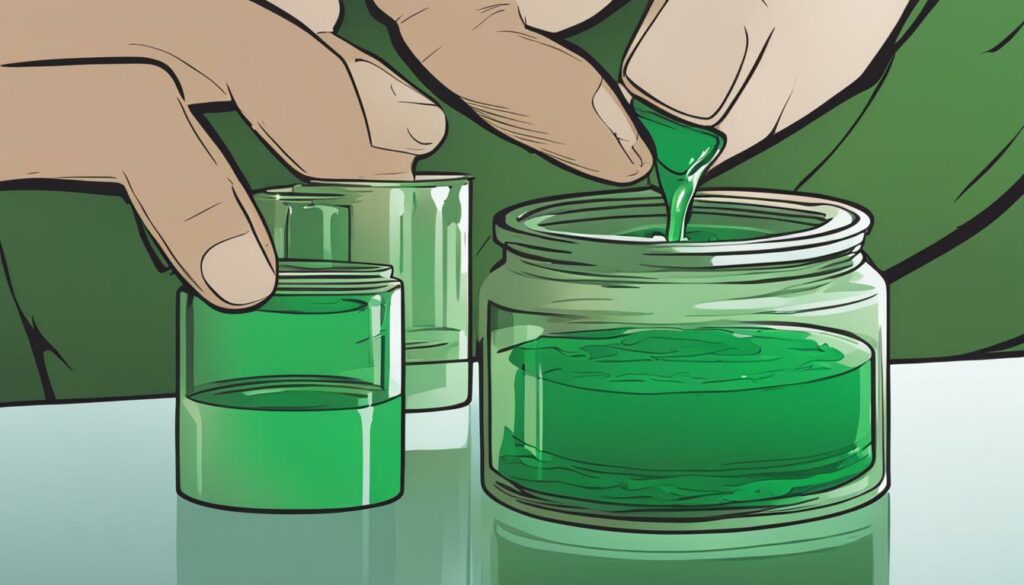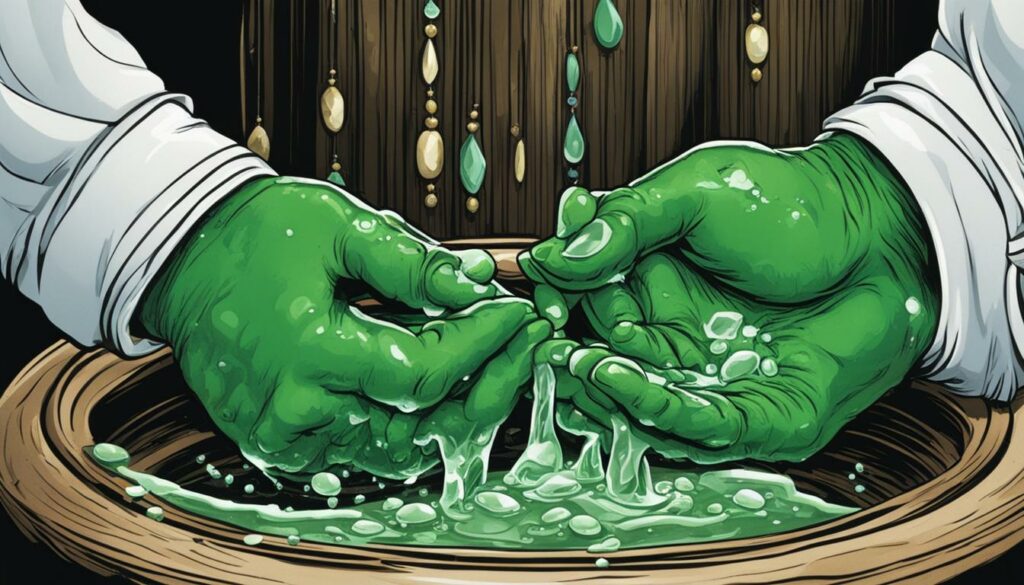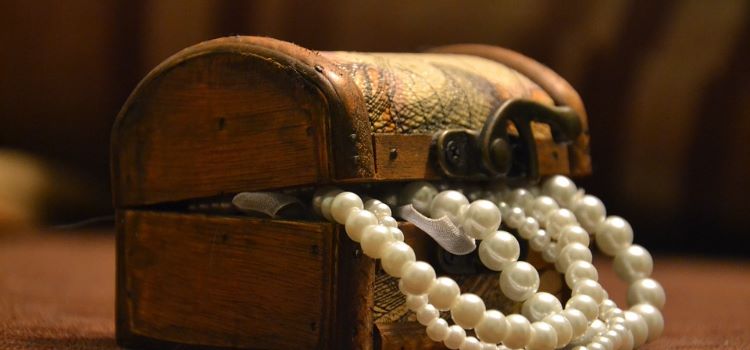Have you ever noticed that your favorite piece of jewelry leaves an unsightly green stain on your skin? It’s a common occurrence and often leaves us wondering why it happens. As a professional copywriting journalist, I’m here to shed some light on the causes of this green discoloration and help you prevent it. So, let’s dive in!
When it comes to jewelry turning our skin green, the culprit lies in the metals used to make the pieces. Jewelry made of metals such as copper, brass, bronze, and certain alloys can react with our skin’s chemistry, causing a chemical reaction that leads to green discoloration. Factors such as perspiration, humidity, and the presence of lotions can worsen the reaction.
But why do these metals react with our skin? The answer lies in their composition. While pure gold and silver won’t cause green skin, most jewelry is made with alloys that contain other metals. For example, gold jewelry is often mixed with copper or other metals to enhance durability. Similarly, sterling silver contains a small percentage of another metal to give it strength. Cheaper costume jewelry may contain higher amounts of copper, brass, or bronze in their alloys.
When these metals come into contact with our skin’s moisture, sweat, or even lotions, they can oxidize, forming a green copper oxide film on the surface. This film can then transfer to our skin, resulting in the dreaded green discoloration. Other metals commonly used in jewelry, such as brass, bronze, and nickel, can also cause similar reactions.
So, how can we prevent our skin from turning green? One option is to coat the jewelry with clear nail polish, creating a temporary barrier between the metal and our skin. However, this solution may require frequent reapplication. Another option is to have the jewelry plated with rhodium, a durable metal that acts as a protective barrier and prevents contact between our skin and the underlying metals. Rhodium plating is a more long-lasting solution but can be more expensive.
To summarize, green skin from jewelry is a result of a chemical reaction between the metals in the jewelry and our skin’s chemistry. Understanding the causes and taking preventive measures like coating or plating the jewelry can help us enjoy our favorite accessories without the green discoloration. Stay tuned for more tips on preventing and dealing with green skin from jewelry!
What Is Your Jewelry Made Of?
When it comes to the materials used in jewelry, it’s important to know what your pieces are made of. While pure gold and silver won’t cause your skin to turn green, most jewelry is made with alloys that contain other metals. Gold and silver are often mixed with metals like copper, nickel, or other alloys to enhance their durability and create different colors and finishes.
Gold jewelry, for example, is typically made with a percentage of gold (10K or higher) mixed with other metals. Sterling silver, on the other hand, is composed of 92.5% silver and 7.5% another metal. Cheaper costume jewelry is often made with alloys that mimic the appearance of gold or silver, but contain higher amounts of metals like copper, brass, or bronze.
Understanding the composition of your jewelry is crucial in determining its potential to cause green discoloration on your skin. Different metals can react differently with your skin’s chemistry, resulting in various reactions that may lead to green stains or discoloration.
Table: Common Metals Found in Jewelry
| Metal | Properties | Reactivity with Skin |
|---|---|---|
| Gold | Durable, malleable, and resistant to tarnish | No reaction, unless mixed with reactive metals like copper or nickel |
| Silver | Soft, lustrous, and prone to tarnish | No reaction, unless mixed with reactive metals like copper or nickel |
| Copper | Durable and easily oxidizes | Can cause green discoloration due to copper oxide film formation |
| Nickel | Hard and resistant to corrosion | Can cause allergic reactions and green discoloration in some individuals |
Remember, everyone’s skin chemistry is different, so what may cause green skin for one person may not have the same effect on others. Opting for high-quality jewelry made of solid gold, sterling silver, or platinum is generally less likely to cause green skin. If you’re allergic to certain metals like nickel, it’s important to avoid jewelry containing those metals to prevent any adverse reactions.
The Role of Copper and Other Metals
Copper is a common culprit in causing green skin from jewelry. When copper comes into contact with the skin’s moisture, sweat, and even lotions, it oxidizes, forming a green copper oxide film on the surface. This film can transfer to the skin, resulting in green discoloration. Other metals commonly used in jewelry alloys, such as brass, bronze, and nickel, can also cause similar reactions.
| Metal | Reaction with Skin |
|---|---|
| Copper | Oxidizes and forms a green copper oxide film |
| Brass | May cause green discoloration on the skin |
| Bronze | Can react with skin chemistry and result in greenish tint |
| Nickel | Commonly causes skin allergies and may lead to green skin |
It’s important to note that everyone’s skin chemistry is different, so reactions may vary from person to person. Some individuals may be more sensitive to certain metals, while others may not experience any discoloration at all. Additionally, the severity of the green discoloration can depend on factors like the length of time the jewelry is worn and the specific conditions the jewelry is exposed to, such as heat and humidity.
To minimize the risk of green skin from jewelry, it is recommended to opt for high-quality pieces made of solid gold, sterling silver, or platinum. These metals are less likely to cause skin reactions compared to alloys containing copper or other reactive metals. If you do choose to wear jewelry made with copper or other metals known to cause discoloration, it’s important to remove the jewelry regularly and clean it thoroughly to prevent the buildup of oils, sweat, and other substances that can intensify the chemical reaction with the skin.
Gold and Silver Plating
Gold and silver plating is a popular technique used in jewelry manufacturing to enhance the appearance of base metals. By applying a thin layer of gold or silver onto a non-precious metal like copper, the jewelry can achieve a more luxurious and expensive look. However, it’s important to note that over time, the plating can wear off, exposing the underlying metal and potentially causing green discoloration on the skin.
To prevent the green stains caused by exposed metals, one effective solution is to have the jewelry re-plated with rhodium. Rhodium is a hard metal that not only adds luster to the jewelry but also acts as a protective barrier between the skin and the underlying metals. Rhodium plating is a more durable option compared to gold or silver plating alone, ensuring that the jewelry maintains its quality and appearance for a longer period of time.
While gold and silver plating can enhance the beauty of jewelry, it’s important to consider the maintenance required. Regular cleaning and proper storage can help prolong the life of the plating and reduce the risk of green skin. It’s also worth noting that opting for high-quality jewelry made of solid gold, sterling silver, or platinum can eliminate the need for plating altogether, as these precious metals are less likely to cause green discoloration on the skin.
| Pros | Cons |
|---|---|
| Enhances the appearance of base metals | Plating can wear off over time |
| Provides a more luxurious look | Exposes underlying metal, potentially causing green discoloration |
| Can be re-plated with rhodium for added durability | Requires regular cleaning and maintenance |
| High-quality jewelry made of solid gold, sterling silver, or platinum eliminates the need for plating |
What Makes Your Skin Turn Green?
When it comes to the phenomenon of jewelry turning our skin green, there are a few key factors at play. One of the main culprits is the chemical reaction that occurs between the metals in our jewelry and the chemistry of our skin. This reaction is often intensified by factors such as perspiration, heat, humidity, and the use of lotions. So, if you find that your jewelry is leaving behind a green tint on your skin, it may be due to this chemical reaction.
In addition to sweat and humidity, exposure to chlorine can also contribute to the green discoloration of our skin. Chlorine is commonly found in swimming pools, and when it comes into contact with the metals in our jewelry, it can cause a chemical reaction that leads to the green tint. Similarly, soap particles clinging to our jewelry can also trigger this reaction. So, it’s essential to be mindful of these factors to prevent green skin.
To summarize, the factors that influence our skin turning green from jewelry include the chemical reaction between metals in our jewelry and our skin’s chemistry, as well as factors like sweat, heat, humidity, chlorine exposure, and soap particles. Understanding these factors can help us take proactive measures to prevent green skin and keep our jewelry-wearing experience pleasant and free from discoloration.
Table: Factors Influencing Green Skin
| Factors | Description |
|---|---|
| Sweat and Humidity | Perspiration and high levels of humidity can intensify the chemical reaction between metals and our skin, leading to green discoloration. |
| Chlorine Exposure | Swimming in chlorinated water or having jewelry come into contact with chlorine can trigger a chemical reaction that causes green skin. |
| Soap Particles | Soap residue clinging to our jewelry can contribute to the chemical reaction that leads to green discoloration of the skin. |
By being aware of these factors and taking preventive measures such as cleaning our jewelry regularly, storing it in a dry environment, and avoiding prolonged exposure to sweat, heat, humidity, chlorine, and soap, we can minimize the likelihood of our skin turning green. Additionally, opting for high-quality jewelry made of precious metals is also a wise choice, as these metals are less likely to cause the chemical reactions that result in green skin. So, with a little care and attention, we can enjoy wearing our jewelry without worrying about the unwanted green tint on our skin.
How to Prevent Your Skin Turning Green?
To prevent the skin from turning green when wearing jewelry, there are a few strategies you can try. One option is to coat the jewelry with clear nail polish, acting as a temporary barrier between the metal and your skin. This can be especially useful for costume jewelry or pieces that are prone to causing green skin. However, it’s important to note that the nail polish may need to be reapplied frequently as it can wear off over time.
Another more durable solution is to have your jewelry plated with rhodium. Rhodium is a hard metal that acts as a protective barrier, preventing direct contact between your skin and the underlying metals. Rhodium plating can be done by a professional jeweler and offers a longer-lasting solution compared to clear nail polish. However, it is worth noting that rhodium plating can be more expensive.
When considering how to prevent green skin from jewelry, it’s important to find the method that works best for you. Whether it’s using clear nail polish or opting for rhodium plating, these measures can help minimize the chances of experiencing green discoloration when wearing your favorite pieces.
Table: Pros and Cons of Coating and Rhodium Plating
| Pros | Cons | |
|---|---|---|
| Coating with Clear Nail Polish | – Temporary barrier – Cost-effective solution |
– Requires frequent reapplication – May wear off over time |
| Rhodium Plating | – Durable barrier – Long-lasting solution |
– More expensive option – Requires professional plating |
Both coating jewelry with clear nail polish and opting for rhodium plating have their advantages and disadvantages. Clear nail polish provides a temporary and cost-effective solution, but it may require frequent reapplication. On the other hand, rhodium plating offers a more durable and long-lasting barrier, but it can be a pricier option and requires professional plating. Consider your budget and the longevity you desire when deciding which method to employ in preventing green skin from jewelry.
Does Green Skin from Jewelry Go Away?
Green skin from jewelry is typically temporary and can be washed off with mild soap and warm water. The green color is a residue from the copper oxide film, which can be stubborn but eventually fades. However, if you experience itching or a rash along with green skin, it may indicate an allergic reaction to nickel, another common metal used in jewelry alloys. Nickel allergies often persist and require avoiding jewelry containing nickel.
If you notice green skin after wearing jewelry, don’t panic. Simply wash the affected area with mild soap and warm water, gently scrubbing to remove the green residue. In most cases, this will effectively remove the green tint and restore your skin’s normal appearance.
However, if the green discoloration persists despite washing, it could be a sign of an allergic reaction or a more persistent chemical reaction between your skin and the jewelry. If you suspect an allergic reaction, it’s best to consult a dermatologist for further evaluation and advice on how to manage the allergy.
Remember, green skin from jewelry is usually temporary and harmless, but if you experience persistent green discoloration or any discomfort, it’s always best to seek professional advice.
Common Causes of Persistent Green Skin
While temporary green skin is often caused by the residue of the copper oxide film, persistent green discoloration can have other underlying factors. Some common causes include:
- Nickel allergies: If you have an allergic reaction to nickel, even small amounts of this metal in jewelry can cause persistent green skin.
- Prolonged exposure to moisture: Moisture can increase the likelihood of a chemical reaction between your skin and jewelry, leading to prolonged green skin.
- Poor quality jewelry: Cheap, low-quality jewelry made with base metals or high concentrations of reactive metals like copper and brass may contribute to persistent green skin.
If you regularly experience persistent green skin despite taking preventive measures, it may be worth investing in high-quality jewelry made of hypoallergenic metals like solid gold, sterling silver, or platinum. These metals are less likely to cause skin reactions and are generally safer for those with sensitive skin or nickel allergies.
By understanding the causes of green skin from jewelry and taking the necessary precautions, you can minimize the risk of experiencing this temporary discoloration and enjoy wearing your favorite pieces without worry.
| Common Causes of Persistent Green Skin | |
|---|---|
| Nickel allergies | If you have an allergic reaction to nickel, even small amounts of this metal in jewelry can cause persistent green skin. |
| Prolonged exposure to moisture | Moisture can increase the likelihood of a chemical reaction between your skin and jewelry, leading to prolonged green skin. |
| Poor quality jewelry | Cheap, low-quality jewelry made with base metals or high concentrations of reactive metals like copper and brass may contribute to persistent green skin. |

Tips to Prevent Jewelry from Turning Skin Green
Preventing your skin from turning green when wearing jewelry can be achieved through simple yet effective measures. By following these tips, you can keep your skin free from green discoloration and enjoy wearing your favorite accessories:
Cleaning Jewelry Regularly
Regularly cleaning your jewelry is essential to prevent the buildup of sweat, lotions, and dirt that can worsen the reaction between the metals and your skin. Use mild soap and warm water to gently clean your jewelry, paying attention to crevices and hidden areas. With a soft cloth or brush, remove any residue and ensure your jewelry is thoroughly dry before wearing it again. By maintaining the cleanliness of your jewelry, you minimize the chances of green discoloration.
Storing in a Dry Environment
Proper storage of your jewelry is also crucial in preventing green skin. Moisture and humidity can accelerate the oxidation process of metals, leading to faster discoloration. Store your jewelry in a dry environment, such as a jewelry box or a pouch with anti-tarnish properties. Keep it away from bathrooms and other areas prone to high moisture levels. By protecting your jewelry from excessive moisture, you can help prolong its longevity and reduce the risk of green skin.
Avoiding Moisture and Sweat
Although it may seem obvious, avoiding contact between your jewelry and moisture or sweat can significantly prevent green skin. Remove your jewelry before activities that may cause excessive perspiration, such as exercising or spending time in hot and humid environments. Additionally, take off your jewelry before swimming, as chlorinated water can react with the metals and contribute to discoloration. By being mindful of moisture and sweat exposure, you can keep your skin free from green stains and enjoy your jewelry worry-free.

| Tips to Prevent Green Skin | Effectiveness |
|---|---|
| Clean jewelry regularly with mild soap and warm water | High |
| Store jewelry in a dry environment | High |
| Avoid moisture and sweat contact | High |
Which Jewelry Is Most Likely to Cause Green Skin?
When it comes to jewelry that is more likely to cause green skin, it often comes down to the type of metals or alloys used. Costume jewelry, which is often made with lower-quality metals, is more likely to cause skin discoloration. These base metals, such as brass, copper, pewter, and aluminum, can react with the skin’s chemistry and lead to green discoloration. It’s important to note that everyone’s skin chemistry is different, so what may cause green skin for one person may not have the same effect on others.
To minimize the risk of green skin, it’s advisable to opt for high-quality jewelry made of solid gold, sterling silver, or platinum. These metals are less likely to cause skin reactions and are often hypoallergenic. Additionally, jewelry made with higher percentages of gold or silver, such as 14K gold or 925 sterling silver, can also reduce the likelihood of green skin.
| Type of Jewelry | Likelihood of Green Skin |
|---|---|
| Solid Gold | Low |
| Sterling Silver | Low |
| Platinum | Low |
| Costume Jewelry | High |
By choosing high-quality metals and avoiding costume jewelry made with base metals, you can greatly reduce the chances of experiencing green skin from your jewelry.
How to Remove Green Stains from Skin
If your skin has been affected by green discoloration caused by jewelry, there are effective ways to remove the stains and restore your skin’s natural color. Here are some simple steps you can follow:
- Start by washing the affected area with mild soap and warm water. Gently lather the soap and use your fingers to scrub the stained skin. This will help remove any residue from the oxidized metals.
- If the green tint persists, you can use rubbing alcohol as a further treatment. Apply a small amount of rubbing alcohol to a cotton pad or swab and gently rub it over the stained area. The alcohol helps to lift the stain and restore your skin’s color.
- After using rubbing alcohol, rinse the area with warm water to remove any remaining residue. It’s important to be gentle with your skin, as rubbing alcohol can be drying. Consider moisturizing the area afterward to keep your skin hydrated and healthy.
By following these steps, you can effectively remove green stains from your skin caused by jewelry. However, it’s essential to address the root cause of the green discoloration to prevent it from happening again in the future.

Remember, prevention is key in keeping your skin free from green discoloration. Regularly clean your jewelry to remove any buildup of sweat, lotions, and dirt. Avoid wearing jewelry in situations where it may come into contact with moisture or chemicals, such as swimming in chlorinated water or using harsh soaps.
Additionally, consider opting for high-quality jewelry made of solid gold, sterling silver, or platinum, as these metals are less likely to cause skin reactions. If you prefer wearing costume jewelry, you can apply a clear coat of nail polish to act as a temporary barrier between the metal and your skin. However, keep in mind that nail polish will need to be reapplied regularly.
Dealing with Green Skin – Clear Coat or Better Metals?
If you’re tired of dealing with green skin from your jewelry, there are a couple of options that can help alleviate this issue. You can try using clear nail polish as a temporary barrier between the metal and your skin. Simply apply a thin layer of clear nail polish to the back and inner sides of your jewelry, allowing it to dry completely before wearing. This can create a barrier that prevents direct contact between your skin and the metal, reducing the chances of green discoloration.
However, keep in mind that clear nail polish may need to be reapplied periodically, especially if you frequently wash your hands or come into contact with water. It’s also important to note that some people may be sensitive or allergic to certain chemicals present in nail polish, so if you experience any adverse reactions, discontinue use immediately.
Another option to consider is re-plating your jewelry with a more durable and hypoallergenic metal, such as rhodium. Rhodium plating can provide a long-lasting solution to prevent green skin, as it acts as a protective barrier between the underlying metal and your skin. While this may be a more expensive option, it can significantly reduce the chances of green discoloration and provide a beautiful, lustrous finish to your jewelry.
Ultimately, investing in high-quality jewelry made of solid gold, sterling silver, or platinum is the best way to minimize the risk of green skin. These metals are less likely to react with the skin and cause discoloration. While they may come at a higher price point, they offer durability, elegance, and peace of mind knowing that your jewelry won’t turn your skin green.
Comparison Table: Clear Coat vs. Re-Plating vs. High-Quality Metals
| Clear Nail Polish | Re-Plating | High-Quality Metals | |
|---|---|---|---|
| Effectiveness | Temporary solution, requires frequent reapplication | Long-lasting solution, provides a protective barrier | Long-lasting solution, less likely to cause skin reactions |
| Cost | Affordable | Varies depending on the jewelry and metal | Higher price point |
| Allergies | Possible reactions to chemicals in nail polish | Depends on the underlying metal and plating material | Hypoallergenic, less likely to cause allergies |
| Appearance | Might alter the original finish or color of the jewelry | Can restore the original appearance and luster | Elegant and timeless |
Table: Comparison of different methods to prevent green skin from jewelry
Conclusion
After exploring the reasons behind jewelry turning the skin green, it is clear that this phenomenon is a result of chemical reactions between the metals in the jewelry and the chemistry of the skin. While green skin does not necessarily indicate poor quality, there are effective ways to prevent or minimize this discoloration.
To prevent jewelry from turning your skin green, consider coating it with clear nail polish as a temporary barrier. However, keep in mind that this method requires frequent reapplication. Alternatively, opt for rhodium plating, a durable solution that acts as a protective barrier between your skin and the underlying metals.
In addition to these preventive measures, it is important to regularly clean your jewelry to remove any buildup of sweat, lotions, or dirt. Storing your jewelry in a dry environment and avoiding exposure to moisture and humidity can also help prevent the onset of green skin. Lastly, consider investing in high-quality jewelry made of precious metals like solid gold, sterling silver, or platinum, as these materials are less likely to cause skin discoloration.
FAQ
Why does jewelry turn the skin green?
Jewelry made of metals such as copper, brass, bronze, and certain alloys react with the skin’s chemistry, causing a chemical reaction that leads to green discoloration.
What is jewelry made of?
Most jewelry is made with alloys of gold and silver that contain other metals like copper, nickel, or other alloys to enhance durability.
What role does copper play in causing green skin from jewelry?
Copper is a common culprit in causing green skin from jewelry. When copper comes into contact with the skin’s moisture, sweat, and even lotions, it oxidizes and forms a green copper oxide film on the surface.
What is gold and silver plating?
Gold and silver plating is when a non-precious metal like copper is coated with a thin layer of silver or gold. Over time, the precious metal coating can wear off, exposing the underlying metal (often copper) and potentially leading to green discoloration.
What factors make the skin turn green from jewelry?
Factors such as perspiration, heat, humidity, and the use of lotions can worsen the chemical reaction between the metals in your jewelry and the chemistry of your skin, resulting in green skin.
How can I prevent my skin from turning green?
You can try coating the jewelry with clear nail polish to create a temporary barrier between the metal and your skin. Another option is to have the jewelry plated with rhodium, a durable metal that acts as a protective barrier. Regular cleaning and avoiding moisture also help prevent green skin.
Does green skin from jewelry go away?
Green skin from jewelry is typically temporary and can be washed off with mild soap and warm water. The green color is a residue from the copper oxide film, which eventually fades. However, persistent green skin may indicate an allergic reaction to nickel.
How can I prevent jewelry from turning my skin green?
To prevent jewelry from turning your skin green, regularly clean your jewelry, store it in a dry environment, and avoid wearing it in situations that may introduce moisture or chemicals. Investing in high-quality jewelry made of solid gold, sterling silver, or platinum is also recommended.
Which jewelry is most likely to cause green skin?
Costume jewelry made with lower-quality alloy metals, such as brass, copper, pewter, and aluminum, is more likely to cause green skin. Fashion jewelry made with base metals can also lead to skin discoloration.
How can I remove green stains from my skin?
You can remove green stains from your skin by washing the affected area with mild soap and warm water. Gently scrubbing with a nail brush can help remove stubborn stains. If the green tint persists, you can use rubbing alcohol applied to a cotton pad or swab to further lift the stain.
Should I use a clear coat or opt for better metals to deal with green skin?
Some people find that using a clear coat of nail polish on cheaper costume jewelry can act as a temporary barrier. However, reapplying the clear coat frequently is necessary. Another option is to have gold or silver-plated jewelry re-plated by a professional jeweler. Opting for high-quality jewelry made of solid gold, sterling silver, or platinum is also recommended, as these metals are less likely to cause green skin.
How can I prevent jewelry from turning my skin green?
To prevent jewelry from turning your skin green, regularly clean your jewelry, store it in a dry environment, and avoid wearing it in situations that may introduce moisture or chemicals. Investing in high-quality jewelry made of solid gold, sterling silver, or platinum is also recommended.
Source Links
- https://www.rd.com/article/green-skin-copper-jewelry/
- https://www.luvari.com/blogs/education/why-does-jewelry-turn-skin-green
- https://nuevaluxe.com/blogs/news/why-does-some-jewelry-turn-skin-green

Hey lovely readers! My name is Chantal and I am obsessed with everything accessory and jewelry. My husband (and best friend) John and I, have been writing content for this blog for over 4 years now started the RTP store with over 4000 curated accessories and jewelry. We are traveling around the world to find the latest products, negotiate the best prices and find the best quality for our readers. We have managed to make our passion for feeling and looking good into our work. We are always open to new product suggestion, improvements or feedback. If you would like to chitchat with me, email me here!




